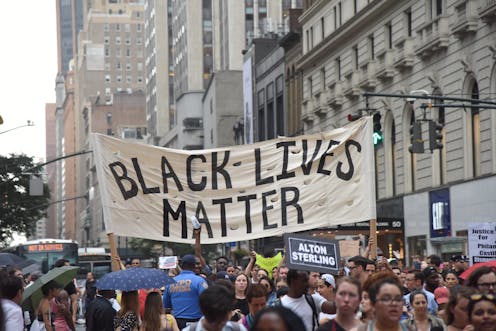Police are more likely to kill men and women of color
- Written by Frank Edwards, Assistant Professor, School of Criminal Justice, Rutgers University Newark

Michael Brown was killed by police in Ferguson, Missouri, five years ago. Since then, U.S. police have killed[1] more than 5,000 people.
Researchers and activists only know about these deaths because journalists do what the federal government has not: collect detailed information[2] on police-involved fatalities.
Because the government has not collected systematic data on police killings, the public doesn’t have definitive numbers that, once interpreted, will show how likely people are to be killed by police.
In a study published on Aug. 5[3], sociologist Hedwig Lee[4], social scientist Michael Esposito[5] and I[6] use unofficial data to show how risk of death varies by age, sex and race or ethnicity in the U.S.
Measuring police violence
My colleagues and I rely on data provided by Fatal Encounters, a dataset maintained by journalist and former newspaper editor D. Brian Burghart[7]. Burghart conducts systematic searches of online news, social media and public records to provide a close-to-comprehensive and up-to-date archive of police killings.
The database shows about 1,000 and 1,200 deaths per year since 2000.
While overall, police are responsible for a very small share of all deaths – about 0.05% of all male deaths, and 0.003% of all female deaths, police are responsible for a substantial proportion of all deaths of young people.
For young men, police violence ranks as the sixth leading cause of death as classified by the National Vital Statistics System[8], after accidents, which include drug overdoses, motor vehicle accidents and other accidental deaths; suicides; other homicides; heart disease; and cancer. Police are responsible for 1.6% of all deaths of black men between the ages of 20 and 24.
Our analysis found that about 52 of every 100,000 men and boys, and about 3 of every 100,000 women and girls, will be killed by police.
For comparison, the lifetime risk of a person being killed in a vehicle accident for the general population is about 970 per 100,000, and the lifetime risk of being killed by firearm in a homicide is about 350 per 100,000.
People who are American Indian and Alaska Native, black or Latino are more likely to be killed by police than people who are white.
Men of color have especially high lifetime risks of being killed by police. About 1 in 1,000 black men and boys are likely are killed by police. For American Indian and Alaska Native men and boys, the lifetime risk of being killed by police is about 1 in 2,000.
Young men and women are at greatest risk of being killed by police. Between the ages of 25 and 29, about 2 of every 100,000 young men in the U.S. are killed by police, while about 0.1 of every 100,000 women will be killed by police.
That risk is most pronounced for young men and women of color.
Policy implications
Based on our results, I believe that the U.S. urgently needs to reduce the rates at which police kill civilians, and reduce inequalities in exposure of men and women to police violence.
In my view, some common sense interventions would likely drive down rates of death. For example, investment in community based mental health and social services[9] would reduce the use of police, jails and prisons as catch-all responses to social problems[10].
Accountability and effective reform demands better data. The Bureau of Justice Statistics is pursuing a data collection effort[11] that mirrors the news-based approaches that journalists have pioneered. And the Center for Policing Equity[12], a research center in New York, is developing a national data system to track police use of force.
These efforts are promising, and I think they will provide policymakers and activists better sets of tools to hold police departments accountable for reducing the number of deaths that their officers cause.
References
- ^ U.S. police have killed (fatalencounters.org)
- ^ detailed information (openhealthdata.metajnl.com)
- ^ a study published on Aug. 5 (www.pnas.org)
- ^ Hedwig Lee (artsci.wustl.edu)
- ^ Michael Esposito (www.mhesposito.com)
- ^ and I (scholar.google.com)
- ^ D. Brian Burghart (fatalencounters.org)
- ^ National Vital Statistics System (www.cdc.gov)
- ^ and social services (www.versobooks.com)
- ^ catch-all responses to social problems (www.ucpress.edu)
- ^ is pursuing a data collection effort (www.bjs.gov)
- ^ Center for Policing Equity (policingequity.org)
Authors: Frank Edwards, Assistant Professor, School of Criminal Justice, Rutgers University Newark
Read more http://theconversation.com/police-are-more-likely-to-kill-men-and-women-of-color-121158

